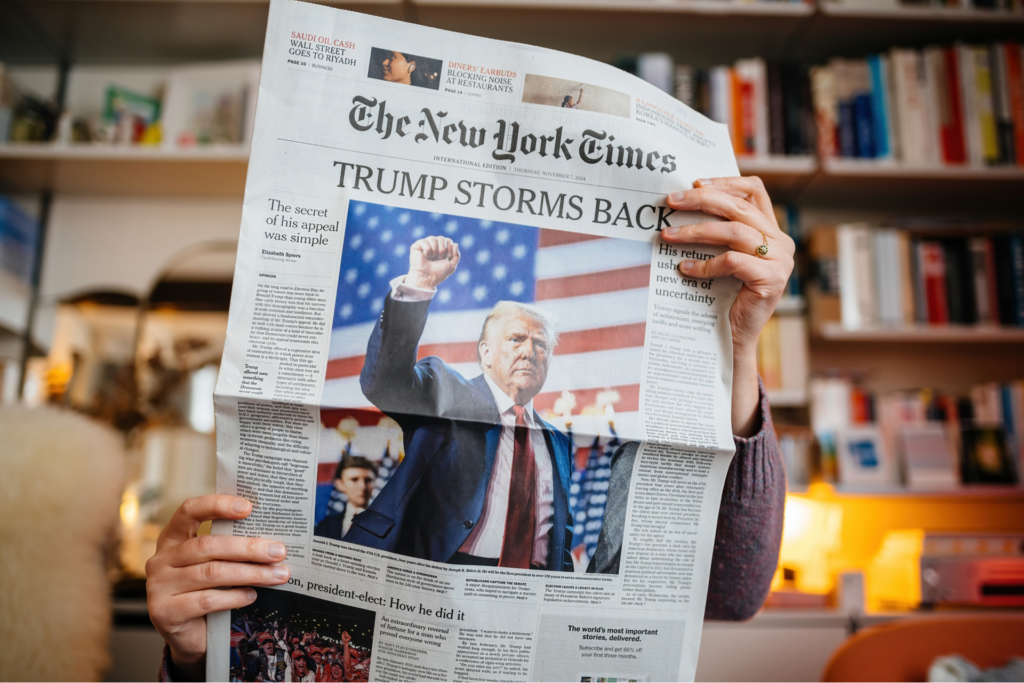What Trumps Second Term Means For E&C and HR


This blog explores potential shifts in the regulatory landscape following Donald Trump's victory in the November 2024 U.S. presidential election.
As Ethics & Compliance (E&C) and Human Resources (HR) professionals, anticipating regulatory changes is crucial for effective corporate governance and risk management. The historic results of the 2024 election and a second non-consecutive term for Donald Trump has the potential to generate massive shifts in the current state of government oversight, and the internal priorities of businesses worldwide.
Our analysis examines the most likely regulatory shifts of a Donald Trump presidency with the Republican party in control of Congress, The Senate, and The Supreme Court. It’s important to note that while significant policy changes often require long-term legislative action, the most immediate impacts are likely to stem from shifting priorities within executive branch agencies and new political appointments, such as in the Department of Justice.
What sets this analysis apart is the use of machine learning to conduct a dispassionate and nonpartisan analysis of Donald Trump. We employed an AI tool, to analyze his stated platforms, past actions, and leadership style to develop a composite profile to predict potential policy directions. This approach allows us to offer unique insights while maintaining objectivity. See the bottom of this report for a detailed Methodology explanation.
We encourage E&C and HR professionals to use this analysis as a foundation for strategic planning over the next four years, keeping in mind that long-term legislative changes may be limited due to potential congressional gridlock and recent trends favoring obstruction over compromise. Our goal is to provide you with a comprehensive overview of possible regulatory shifts, empowering you to proactively consider their impact on your roles and responsibilities.
First Scenario: Trump Wins
A second Trump presidency coupled with Republican control of Congress could lead to significant changes in the regulatory landscape, particularly in areas such as immigration, labor laws, and corporate governance.
Immigration Policy
The Trump campaign has pledged to implement what it calls “the largest domestic deportation operation in American history.” This aggressive approach to immigration enforcement could have significant implications for workforce stability and HR strategies across various industries. Trump has also indicated he would seek to reduce legal immigration, which could significantly impact talent acquisition of skilled workers.1 2
- Stricter immigration enforcement
- Mass Deportation Policies: Trump has proposed invoking the 1798 Alien Enemies Act to bypass due process in deporting suspected members of drug cartels or criminal gangs. While the legality of such an approach would likely face court challenges, even the attempt to implement such policies could create uncertainty and disruption in the labor market. Industries heavily reliant on immigrant labor, such as agriculture, construction, and hospitality, could face significant workforce disruptions. HR professionals in these sectors may need to develop contingency plans for potential labor shortages and increased turnover.3 4 5
- Impact on Workforce Availability and Supply Chain Disruptions: The construction industry, which employs approximately 20% immigrant labor, could face particular challenges. Similar impacts could be felt in service industries. E&C professionals may need to assess and mitigate risks associated with potential disruptions to supply chains and project timeliness due to labor shortages.
- Overhaul of legal immigration system
- Reductions in Work Visas and Green Cards: Proposals to limit legal immigration pathways could affect various visa programs, including H-1B visas for skilled workers. This could negatively impact sectors reliant on foreign talent such as in technology, higher education, and healthcare.6 HR professionals in these sectors may need to develop new strategies for talent attraction and retention in a more restrictive immigration environment.7
Labor and Employment
Despite attempts in 2024 to appeal to pro-union voters, Trump’s campaign, colleagues, and the actions of his first administration have shown he favors deregulation of worker protections by opposing rules about wages and overtime, appointing anti-labor judges, and weakening workers’ collective bargaining rights.8 9
- Significant rollback of worker protections
- Potential Repeal or Modification of Pro-Labor Regulations: Trump has expressed intentions to reduce the power and independence of federal agencies. This could result in the weakening or repeal of various worker protection regulations. For instance, there might be attempts to roll back Obama-era rules on overtime pay, joint employer standards, or workplace safety regulations. HR professionals may need to revisit and potentially revise policies related to subjects.3 8
- Weakening union power and the EEOC
- Shift in Enforcement Priorities and Interpretation of Labor Laws: The National Labor Relations Board (NLRB) under a Trump administration might prioritize employer rights over employee protections, potentially reversing Obama and Biden-era decisions on issues like joint employer standards or employee handbooks. The Equal Employment Opportunity Commission (EEOC) could also see a shift in focus, potentially de-emphasizing systemic discrimination investigations in favor of individual complaint resolution.10 The EEOC’s emphasis on proactive measures to prevent discrimination could be reduced. However, if workers have limited outlet or recourse through the EEOC, they might take their case on social media, opening organizations up to reputational harm. To mitigate this risk, E&C and HR teams may seek to open need issue intake channels to alleviate feelings of helplessness from workers.
Environmental Regulations
Trump has regularly made discussions about the energy sector a staple of his 2024 campaign with calls for increased production of fossil fuels while disparaging the use of renewable energy systems. He has stated he intends to withdraw the United States from the 2015 Paris Climate Agreement and weaken federal legislation promoting sustainability.3 11
- Dismantling of climate change initiatives
- Potential Repeal of Inflation Reduction Act (IRA) and CHIPS Act Provisions: Trump has pledged to press Congress to gut the Inflation Reduction Act and rescind all unspent funds under the legislation. This could significantly impact clean energy initiatives and related tax credits, especially in the manufacturing, energy, construction, and agriculture industries. Without the tax credit incentives, organizations may have their E&C teams deprioritize ESG goals.12
- Implications for Corporate Sustainability Programs and ESG Reporting: Companies may seek to reevaluate their sustainability strategies. ESG reporting requirements could be relaxed and E&C teams would no longer be expected to conduct ESG-related training.13 However, it should be noted that in the age of consumer activism, companies will still face pressure from investors and consumers to maintain robust sustainability practices.
- Deregulation of energy sector
- Impact on Businesses’ Long-Term Energy Strategies and Compliance Programs: Trump has promised to ease restrictions on fossil fuel production. This might create a more complex regulatory landscape for E&C and legal professionals in the energy and manufacturing sector as reduced federal oversight will leave behind a patchwork of state and local regulations.14 When the first Trump Administration sought to rollback automobile emission standards, manufacturers pushed back claiming they would fall behind in development if they ignored market pressures to reduce emissions.15 Pressure from stakeholders and customers to maintain high environmental standards will not abate in spite of changes in restrictions. Therefore, E&C professionals will need to be more adaptable and proactive, balancing compliance with industry best practices, heightened public scrutiny, and the expectation of federal oversight returning under another administration.
Healthcare and Benefits
At various points during the first Trump administration, unsuccessful efforts were made by Republicans to repeal the Affordable Care Act (ACA) or remove its provisions. Many proposals put forward by Trump’s colleagues consisted of market-based solutions, believing this will increase efficiency and reduce prices.16
- Attempts to repeal or significantly modify the Affordable Care Act (ACA)
- Potential impacts on employer-sponsored health plans: The elimination of the employer mandate could remove the requirement for large employers to offer affordable health coverage. Essential health benefit requirements might be removed, allowing for more flexibility in plan design. There may also be changes to dependent coverage rules, such as modifying the provision allowing children to remain on parents’ plans until age 26.17 There could be a potential elimination of ACA reporting requirements, such as Forms 1094-C and 1095-C which would require a reassessment of health plan offerings.
- Push for market-based healthcare solutions
- Possible expansion of Health Savings Accounts (HSAs): Based on a previous focus during Trump’s first administration on the use of HSAs, a second administration might see increased contribution limits and expanded eligibility criteria for participation. There could also be potential allowances for using HSA funds for a broader range of health-related expenses.18 19
Corporate Governance and Financial Regulations
During his first term, Trump implemented significant deregulation across various sectors, including the financial industry. His administration eased regulations on banks and financial institutions, aiming to reduce what they viewed as burdensome oversight.3
- Significant deregulation of the financial sector
- Potential rollback of Dodd-Frank provisions: Regulations on smaller and medium-sized banks may be further eased. The Volcker Rule, which restricts banks from certain investment activities, could see modifications. There might be possible changes to the Consumer Financial Protection Bureau’s authority and structure.20 21
- Implications for financial compliance programs and risk management: Organizations would need to reassess and potentially restructure existing compliance programs. There would be increased importance placed on internal risk management practices as external regulations are reduced. This could create potential for new opportunities and risks in financial product development and marketing.
- Changes to SEC regulations and enforcement
- Possible reduction in disclosure requirements: Financial reporting requirements might be streamlined. There could be a potential scaling back of non-financial disclosures, such as ESG-related reporting. Possible changes to executive compensation disclosure rules may also be implemented.13 Although concern from regulators about executive conflicts of interest may relax, stakeholder pressure and the reputational losses from bad publicity would remain high.
- Impact on corporate governance practices and E&C programs: Organizations would need to balance reduced regulatory requirements with investor expectations for transparency. This might lead to potential shifts in internal control and audit practices. There would likely be a need for reassessment of whistleblower programs and internal reporting mechanisms in light of potential changes to SEC enforcement priorities.
Trade and Tariffs
Trump’s first term was marked by an aggressive approach to trade, including the implementation of tariffs on various imported goods, particularly electronics, steel, and pharmaceuticals from China. He has indicated a willingness to continue and potentially expand this approach in a second term. In addition to new trade compliance burdens, tariffs cause inflation and prices to rise; therefore, HR teams should prepare for turnover unless wages can be raised.3 22 23
- Implementation of broad tariff increases
- Compliance challenges for import/export businesses: Import/export businesses would face significant challenges in adapting to a new tariff landscape. Companies (especially major importers such as technology, manufacturing, retail, and pharmaceuticals) might need to diversify their supply chains to mitigate the impact of increased tariffs. This could involve seeking new suppliers in different countries or considering reshoring options.24 Compliance teams would need to stay vigilant about rapidly changing tariff regulations and ensure accurate classification of goods to avoid penalties.
- Increased cost of living, demand for higher wages: Tariffs have long been known to cause prices to increase and this burden will be passed on to consumers. Given Trump’s suggested tariffs (and presumably retaliatory tariffs), prices from suppliers will increase within the technology, manufacturing, construction, and pharmaceutical industries. These price increases would be passed on consumers.24 25 If the tariffs are enacted, the cost of living will rise for employees and organizations will begin to suffer retention problems as the workforce seeks better wages. HR teams will have to raise wages quickly to remain competitive.
- Specific tariffs on Chinese imports
- Compliance considerations for businesses with Chinese suppliers or operations: Businesses with Chinese suppliers or operations would face increased scrutiny and potential financial impacts.3 They would need to closely monitor changes in tariff rates and adjust their import strategies accordingly. This might involve implementing more sophisticated tracking systems for country of origin and tariff classification.
- Improvement of due diligence and risk management processes: Companies would likely need to improve their due diligence processes when dealing with Chinese entities which would involve more rigorous supplier screening. Risk management strategies might need to be adjusted to account for potential disruptions in Chinese supply chains or sudden changes in tariff policies.
Data Privacy and Cybersecurity
While the first Trump administration took steps to address cybersecurity concerns, particularly in critical infrastructure regarding national security matters, it did not push for comprehensive federal data privacy legislation. This approach may continue in a second term, but with special attention on protecting American intellectual property.3 26 27
- Federal action on data privacy
- Implications for data management and compliance strategies: A Trump administration might pursue federal legislation that preempts state privacy laws, potentially creating a uniform national standard. While this could simplify compliance for businesses operating across multiple states, it might also result in less stringent privacy protections overall.28 In response, organizations would need to reassess their data management and privacy compliance strategies. This reassessment could involve revising data collection and processing practices, updating privacy policies, and modifying consent mechanisms to align with the new federal standards, which may be less stringent than some existing state laws.
- Focus on cybersecurity as a national security issue
- Potential requirements for infrastructure protection and IT security policies : Building on directions taken during the first Trump administration, there might be increased regulations and standards for critical infrastructure protection, including mandatory cybersecurity measures for sectors such as energy, finance, and healthcare.27 There would be a need to increase investment in cybersecurity technologies, and enhance employee training programs. Compliance teams would need to incorporate these new cybersecurity requirements into their programs and demonstrate adherence to regulators and stakeholders, potentially affecting critical infrastructure sectors most significantly.
Diversity, Equity, and Inclusion (DEI) Initiatives
The Trump administration was critical of DEI initiatives, particularly in federal contracting and education. A second term might see efforts to roll back federal DEI requirements and change the interpretation of anti-discrimination laws.29 30
- Rollback of federal DEI requirements
- Implications for federal contractors and corporate DEI programs: Based on efforts in the first Trump Administration, federal contractors in industries such as defense, pharmaceuticals, construction, technology, and higher education might see a significant reduction in DEI-related requirements for government contracts. This could lead to a reassessment of corporate DEI programs, potentially scaling back initiatives that were previously mandated. However, companies may need to balance any regulatory rollbacks with stakeholder expectations and the recognized benefits of diverse and inclusive workplaces.30 31
- Impact on workplace policies and training programs: Organizations may need to revise their workplace policies and training programs to align with new federal guidance. This could involve re-evaluating diversity hiring targets, modifying inclusion strategies, and potentially altering or reducing DEI-focused training programs.
- Shift in civil rights enforcement
- Potential changes in interpretation of anti-discrimination laws: There could be a narrower interpretation of anti-discrimination laws, focusing more on individual instances of overt discrimination rather than systemic or unconscious biases. This shift might result in fewer investigations into patterns of discrimination and a higher burden of proof for discrimination claims.31
- Effects compliance strategies and E&C risk assessments: During 2017, the first Trump administration’s DOJ did little with the civil rights division and a future administration could see increased politicization of the DOJ.32 33 If this happens, Ethics and Compliance professionals may need to reassess their risk management strategies. However, conventional wisdom suggests it is better in the long-term for an organization to be more compliant, more ethical, and less discriminatory even if the threshold for a violation has been lowered.
Tax Policy
The Tax Cuts and Jobs Act of 2017 (TCJA) was a signature policy of Trump’s first term. In a second term, he might seek to extend or expand these tax cuts, which included reductions in corporate and individual tax rates. Companies might benefit from continued lower corporate tax rates and potentially expanded deductions, influencing decisions on capital investments, repatriation of overseas profits, and overall financial strategies.3 34 35 36
- Impact on employee compensation and benefits
- Effects on how companies structure employee compensation and benefits: Modifications to deductions for certain types of compensation might influence executive pay packages. Additionally, changes in individual tax rates could impact employees’ take-home pay and potentially influence benefit preferences.
Government Restructuring
The “Project 2025” document, while disavowed by Trump, provides insight into the thinking of the conservatives who would become bureaucrats and department heads during a second Trump administration. This document reveals a government restructuring plan which would likely cause competency losses to federal agencies.37
- Potential changes to federal agencies and departments
- Implications for regulatory oversight and enforcement: Project 2025 proposes significant restructuring of federal agencies, which could lead to major shifts in regulatory oversight. For instance, the plan to divide the Centers for Disease Control and Prevention into two weaker entities could result in less stringent health-related regulations.38 In light of weakened enforcement, E&C professionals can decide whether or not to keep post-pandemic health & safety policies in place for their organizations.
- Impact on compliance reporting and interaction with government agencies: The proposed expansion of political appointees, particularly in the Department of Justice, could lead to more politically driven enforcement priorities.32 Companies might need to adjust their compliance strategies to account for potentially inconsistent or politically influenced regulatory interpretations. The plan to allow political appointees to apportion federal funds could also impact how companies interact with and report to government agencies.39
- Shift towards state-level regulation
- Potential challenges for multi-state operations: As federal oversight weakens, state-level regulations may become more prominent and diverse. Companies operating across multiple states could face a more complex regulatory environment, requiring tailored compliance approaches for different jurisdictions. This would increase compliance costs and complexity, particularly for nationwide operations. E&C and HR professionals may need to develop more flexible and localized compliance strategies.
Conclusions
In reflection of this analysis of potential regulatory changes following the 2024 U.S. presidential election, it’s clear that President Trump’s return to office, particularly with Republican congressional support, signals a likely shift toward significant deregulation across multiple sectors. His administration’s stated priorities suggest a continued focus on rolling back environmental protections, labor laws, and immigration policies. While this approach may simplify some compliance processes in the short term, it could create new challenges as organizations navigate reduced federal oversight and an increasingly complex patchwork of state regulations. Not to mention the risk of reputational damage activism in response to a lack of official government oversight.
Statistically speaking, because the United States has had more “conventional presidents” than not, Donald Trump represents an outlier.75 76 A more conventional president is most likely to return after any second Trump administration (which is what happened at the end of the first). Therefore, any deprioritization of enforcement and higher compliance costs is likely to be temporary. Playing the odds, E&C professionals and HR teams would be wise not to lower the bar for their organizations and continue to act as if stricter enforcement will return in the near future. HR professionals will need to be uniquely prepared with retention strategies as Trump’s stated policies towards immigration and tariffs are likely to create labor shortages and increase the cost of living respectively.
Key considerations for E&C and HR professionals include:
- Workforce Disruption: The proposed “largest domestic deportation operation in American history” coupled with restrictions on legal immigration will likely create significant labor shortages, particularly in construction, agriculture, and hospitality sectors. HR teams should prepare contingency plans for workforce stability and retention strategies to address increased wage pressures from inflation due to tariff policies.
- Complex Compliance Environment: While federal oversight may decrease, organizations will face a more complex patchwork of state regulations. This is particularly relevant in areas such as environmental compliance, data privacy, and worker protections. E&C teams should maintain robust compliance programs despite reduced federal enforcement, as historical patterns suggest such changes may be temporary.
- Stakeholder Expectations: Despite potential regulatory rollbacks in areas such as ESG reporting, DEI initiatives, and environmental protections, organizations will continue to face pressure from investors, consumers, and employees to maintain high standards. E&C professionals should balance reduced regulatory requirements with stakeholder expectations for transparency and corporate responsibility.
- Risk Management: The potential weakening of federal agencies, as suggested by Project 2025, combined with increased political influence in enforcement priorities, will require organizations to strengthen their internal risk management processes. This includes maintaining robust whistleblower programs and internal reporting mechanisms despite possible changes in SEC enforcement priorities.
- Cost Management: HR teams will need to navigate potential increases in labor costs due to workforce shortages and inflation from tariffs, while also managing potential changes to healthcare benefits if the ACA faces significant modifications.
Regardless of the results of Trumps second term, E&C and HR professionals should always prepare for a period of some regulatory changes whenever the United States’ presidency is changing (especially if the party of the successor differs from the incumbent). The key to successfully navigating this evolving landscape will be maintaining flexibility in compliance strategies, staying informed about policy developments, and fostering a culture of adaptability within organizations. As we move forward, the ability to quickly assess and respond to new regulatory requirements will be crucial for ensuring continued compliance and capitalizing on potential opportunities that may arise from these changes.
Methodology
This article was written with the help of machine learning to provide speculative hypotheses in a dispassionate and nonpartisan way. While this article was written and sourced by humans, the tool Claude (Claude 3.5 Sonnet) was used solely to assist is speculating on how a Harris or Trump victory might impact the regulatory landscape. As of the time this article was written in early September 2024, Claude’s database had only been updated up to the events of April 2024. Therefore, Claude was provided a host of news stories from moderate/centrist with analyses from think-tanks and non-profits of various political leanings which had been published/updated since April.
Claude was told to “use the candidate’s platforms and their past actions or stances” to develop a list of changes likely to be made if the candidates and their party won the election. Claude was also instructed that it was free to use information from before April 2024 to create composites on “the candidates’ temperate, the candidates’ past behavior, who the candidates take advice from, and the types of people the candidates tend to delegate tasks” and use these composites to assist in determining how they might try to enact their policy goals.
In the creation of the composite overviews of the candidates, facts used by Claude were reviewed and sourced manually. Efforts were made to exclude use of editorials.
References:
¹ Debusmann Jr., Bernd and Mike Wendling. “Could Trump Really Deport One Million Immigrants?” BBC News, 16 Aug. 2024, www.bbc.com/news/articles/ce9z0lm48ngo. Accessed September 2024.
² Haberman, Maggie et. al. “Sweeping Raids, Giant Camps and Mass Deportations: Inside Trump’s 2025 Immigration Plans.” The New York Times, 11 Nov. 2023, www.nytimes.com/2023/11/11/us/politics/trump-2025-immigration-agenda.html. Accessed September 2024.
³ Council on Foreign Relations. “Donald Trump.” Election 2024 Candidate Tracker, Council on Foreign Relations, https://www.cfr.org/election2024/candidate-tracker/donald-trump. Accessed September 2024.
⁴ Ebright, Katherine Yon “What Should Courts Do If a Future President Invokes the Alien Enemies Act to Deport Immigrants?” Just Security, 27 Feb. 2024, www.justsecurity.org/92690/what-should-courts-do-if-a-future-president-invokes-the-alien-enemies-act-to-deport-immigrants/. Accessed September 2024.
⁵ U.S. Bureau of Labor Statistics. “Foreign-Born Workers: Labor Force Characteristics — 2023.” U.S. Bureau of Labor Statistics, 18 May 2023.
⁶ Zielinski, Dave. “Microsoft, Google Seek Green Card Rule Change.” TechTarget, 8 Jun. 2023, www.techtarget.com/searchhrsoftware/news/366583437/Microsoft-Google-seek-green-card-rule-change. Accessed September 2024.
⁷ U.S. Citizenship and Immigration Services. “Employment-Based Immigration.” USCIS.gov, Accessed September 2024.
⁸ Economic Policy Institute. “50 ways the Trump administration has eroded workers’ rights while bolstering corporate power.” Press Releases, Economic Policy Institute, 16 Sept. 2020, https://www.epi.org/press/50-ways-the-trump-administration-has-eroded-workers-rights-while-bolstering-corporate-power/. Accessed September 2024.
⁹ Park, Leah J. “U.S. Department of Labor Rescinds Trump-Era Joint Employer Rule.” Paul, Weiss, Rifkind, Wharton & Garrison LLP, 20 Jul. 2021, www.paulweiss.com/practices/litigation/employment-workplace-investigations-trade-secrets/publications/us-department-of-labor-rescinds-trump-era-joint-employer-rule?id=40684. Accessed September 2024.
¹⁰ McNicholas, Celine, et al. “Unprecedented: The Trump NLRB’s Attack on Workers’ Rights.” Economic Policy Institute, 16 Oct. 2019, www.epi.org/publication/unprecedented-the-trump-nlrbs-attack-on-workers-rights/. Accessed September 2024.
¹¹ Smith, John, and Alice Johnson. “Comparing Trump and Harris on Climate Change Policies.” The Washington Post, 15 Mar. 2024, www.washingtonpost.com/politics/interactive/2024/trump-harris-climate-change/. Accessed September 2024.
¹² Bradner, Robert, et. al. “Potential Implications of a Trump Presidency for Unspent Out-Year Federal Appropriations.” Holland & Knight, 16 Jul. 2024, https://www.hklaw.com/en/insights/publications/2024/07/potential-implications-of-a-trump-presidency-for-unspent. Accessed September 2024.
¹³ Schwartz, Brian. “A Trump SEC would aim to reverse climate disclosure rule, ratchet up ESG fights, sources say” CNBC, 3 May 2024, www.cnbc.com/2024/05/02/trump-sec-would-end-climate-disclosure-rule-target-esg-investments.html. Accessed September 2024.
¹⁴ Blackburn, Piper Hudspeth, et. al. “Promises Donald Trump has made so far in his campaign for a second term.” CNN, 13 Sept. 2024, https://www.cnn.com/interactive/2024/04/politics/trump-campaign-promises-dg/. Accessed September 2024.
¹⁵ Rott, Nathan and Jennifer Ludden. “Trump Administration Weakens Auto Emissions Standards.” National Public Radio, 31 March, 2020, https://www.npr.org/2020/03/31/824431240/trump-administration-weakens-auto-emissions-rolling-back-key-climate-policy. Accessed September 2024.
¹⁶ Kaiser Family Foundation. “Compare Medicare-for-all and Public Plan Proposals.” KFF.org, May 15, 2019.
¹⁷ Centers for Medicare & Medicaid Services. “Affordable Care Act (ACA).” CMS.gov, Accessed September 2024.
¹⁸ Phillips, Kathryn. “Trump Plan To Increase Health Savings Accounts Should Ensure That They Do Not Only Benefit The Wealthy And Healthy.” HealthAffairs, 8 Dec. 2024, https://www.healthaffairs.org/content/forefront/trump-plan-increase-health-savings-accounts-should-ensure-they-do-not-only-benefit. Accessed September 2024.
¹⁹ Ebeling, Ashlea. “Trump Calls For Expanding Health Savings Accounts; A Golf Driver On Uncle Sam’s Dime?” Forbes, 1 Mar. 2017, https://www.forbes.com/sites/ashleaebeling/2017/03/01/trump-calls-for-expanding-health-savings-accounts-a-golf-driver-on-uncle-sams-dime/. Accessed September 2024.
²⁰ Delevingne, Lawrence and Douglas Gillison. “If Trump Wins, He Plans to Free Wall Street from ‘Burdensome’ Regulations.” Reuters, 12 Apr. 2024, www.reuters.com/markets/us/if-trump-wins-he-plans-free-wall-street-burdensome-regulations-2024-04-12/. Accessed September 2024.
²¹ Federal Reserve. “Dodd-Frank Act Stress Test 2023: Supervisory Stress Test Results.” Board of Governors of the Federal Reserve System, Jun. 2023.
²² Graham, Niels. “The US is relying more on China for pharmaceuticals — and vice versa.” Atlantic Council, 20 Apr. 2023. https://www.atlanticcouncil.org/blogs/econographics/the-us-is-relying-more-on-china-for-pharmaceuticals-and-vice-versa/. Accessed September 2024.
²³ Lawder, David. “How Harris’ and Trump’s tax and spending plans affect US debt.” Reuters, 10 Sept. 2024. https://www.reuters.com/markets/us/how-harris-trumps-tax-spending-plans-affect-us-debt-2024-09-10/. Accessed September 2024.
²⁴ Lincicome, Scott, et. al. “Americans Paid for Trump Tariffs and Would Do So Again.” Cato Institute, 19 Aug. 2023, www.cato.org/blog/americans-paid-trump-tariffs-would-do-so-again. Accessed September 2024.
²⁵ York, Erica. “Tracking the Economic Impact of the Trump-Biden Tariffs.” Tax Foundation, 26 Jun. 2024. https://taxfoundation.org/research/all/federal/trump-tariffs-biden-tariffs/. Accessed September 2024.
²⁶ United States, Executive Office of the President. “National Cyber Strategy of the United States of America.” The White House, Sept. 2018.
²⁷ Sabin, Sam. “How Trump could change cybersecurity.” Axios, 3 Sept. 2024, https://www.axios.com/2024/09/03/donald-trump-2024-cybersecurity-agenda. Accessed September 2024.
²⁸ Guliani, Neema. “Don’t Be Fooled by the Tech Industry’s Push for Federal Privacy Legislation.” American Civil Liberties Union, 5 Oct. 2018, https://www.aclu.org/news/privacy-technology/dont-be-fooled-tech-industrys-push-federal-privacy. Accessed September 2024.
²⁹ Nason, Leigh and Lauren Hicks. “The New ‘Race and Sex Stereotyping’ Executive Order Affecting Federal Contractors.” Ogletree Deakins, 29 Sept. 2020. https://ogletree.com/insights-resources/blog-posts/the-new-race-and-sex-stereotyping-executive-order-affecting-federal-contractors/. Accessed September 2024.
³⁰ U.S. Department of Labor. “President Biden Revokes Executive Order 13950.” U.S. Department of Labor, Office of Federal Contract Compliance Programs, https://www.dol.gov/agencies/ofccp/executive-order-13950. Accessed September 2024.
³¹ Moore, ReNika, et. al.”Trump on DEI and Anti-Discrimination Law.” American Civil Liberties Union, 2 Jul. 2024, https://www.aclu.org/publications/trump-on-dei-and-anti-discrimination-law. Accessed September 2024.
³² Lartey, Jamiles. “Trump’s ‘Project 2025’ Plan Targets Progressive Prosecutors and Promises Tough-on-Crime Policies.” The Marshall Project, 20 Jul. 2024, www.themarshallproject.org/2024/07/20/trump-project-2025-crime-prosecutors. Accessed September 2024.
³³ American Federation of Government Employees. “Project 2025 Seeks to Dismantle Agencies, Terminate Up to 1 Million Federal Workers.” American Federation of Government Employees (AFGE) , 15 Jul. 2024, www.afge.org/article/project-2025-seeks-to-dismantle-agencies-terminate-up-to-1-million-federal-workers/. Accessed September 2024.
³⁴ Internal Revenue Service. “Tax Cuts and Jobs Act: A Comparison for Businesses.” IRS.gov, Accessed September 2024.
³⁵ Peter G. Peterson Foundation. “How Did the TCJA Affect Corporate Tax Revenues?” Peter G. Peterson Foundation, 3 May 2024, www.pgpf.org/blog/2024/05/how-did-the-tcja-affect-corporate-tax-revenues. Accessed September 2024.
³⁶ Tax Policy Center. “How Did the Tax Cuts and Jobs Act Change Business Taxes?” Tax Policy Center, Urban Institute and Brookings Institution, January 2024, www.taxpolicycenter.org/briefing-book/how-did-tax-cuts-and-jobs-act-change-business-taxes. Accessed September 2024.
³⁷ The Heritage Foundation. “Project 2025.” Heritage.org. Accessed September 2024.
³⁸ Cancryn, Adam. “Trump Administration Draws Up Plans to Dismantle CDC.” Politico, 11 Mar. 2024, www.politico.com/news/2024/03/11/cdc-dismantle-trump-administration-00146035. Accessed September 2024.
³⁹ Prokop, Andrew. “Project 2025: The myths and the facts.” Vox, 30 Jul. 2024, https://www.vox.com/politics/360318/project-2025-trump-policies-abortion-divorce. Accessed September 2024.
⁴⁰ Dimock, Michael and John Gramlich. “How America Changed During Donald Trump’s Presidency.” Pew Research Center, 21 Jan. 2021, https://www.pewresearch.org/politics/2021/01/29/how-america-changed-during-donald-trumps-presidency/, Accessed September 2024.
⁴¹ Gittleson, Ben. “How Trump obliterated norms and changed the presidency.” ABC News, 19 Jan. 2021, https://abcnews.go.com/Politics/trumps-legacy-obliterated-norms-chipped-institutions-end/story?id=75275806, Accessed September 2024.





































